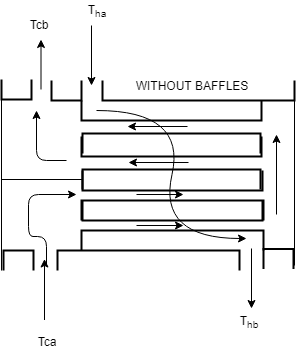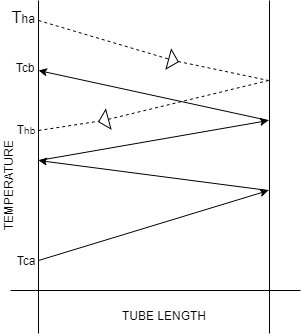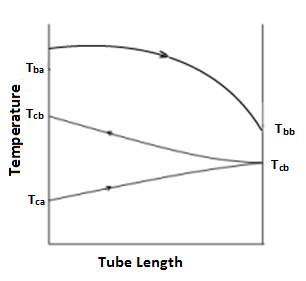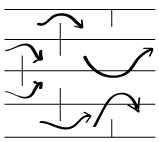This set of Heat Transfer Operations Multiple Choice Questions & Answers (MCQs) focuses on “Classification of Heat Transfer Equipment”.
1. Which of the following is not an Indirect Contact type heat exchanger?
a) Shell and Tube
b) Feedwater Heater
c) Spray and Tray type
d) Plate Type
View Answer
Explanation: Spray and Tray type is a Direct Contact Type heat exchanger which involves the transfer of heat between two immiscible fluids by bringing them into contact at different temperatures. Spray and Tray type heat exchanger involves spraying of liquid in a chamber with cold air, hence it is in direct contact with air.
2. Which of the following is not a classification based on Construction of the heat Exchanger?
a) Tubular
b) Plate Type
c) Multipass
d) Regenerative
View Answer
Explanation: Multipass is a classification based on flow type and not on construction. If we classify a Heat exchanger based on flow type, it would be Multipass and Single-pass.
3. In a ___________ heat exchanger, both fluids flow alternatively through the same flow passages, and hence heat transfer is intermittent.
a) Shell and Tube
b) Fluidised Bed
c) Storage Type
d) Cross Flow Type
View Answer
Explanation: In a Storage Type Heat Exchanger, the heat energy from the hot fluid is first stored in the matrix/wall of the heat exchanger. Wherein, cooling of the hot fluid takes place. As the cold fluid passes through this same matrix later, the stored heat energy in the matrix is transferred to the cold fluid. This intermittent flow pattern of hot fluid and cold fluid is an exclusive property of Storage Type HE.
4. In a Fluidised Bed Heat Exchanger with hot gas flow, at fluidisation the temperature of the bed is ________
a) Linearly Increasing
b) Uniform
c) Linearly Decreasing
d) Decreasing but not Linear
View Answer
Explanation: Under Fluidisation condition, the pressure drop of the fluid through the pellet-bed remains almost constant, which is independent of the fluid flow rate leading to a strong mixing of the solid particles/ pellets. This results in a uniform temperature for the total bed.
5. A gas-to-fluid exchanger can be referred to as a compact heat exchanger if it has a Hydraulic Diameter, DH _____
a) ≤ 6 mm
b) ≤ 12 mm
c) ≥ 6 mm
d) ≥ 3 mm
View Answer
Explanation: It is referred to as a compact heat exchanger if its heat transfer surface area density is greater than about 700-710m2/m3 which means a hydraulic diameter DH ≤ 6 mm for operating in a gas stream.
6. Which of the following is not a characteristic of a Direct-Contact Exchanger?
a) Only heat Transfer occurs without any Mass -Transfer
b) The Exchanger Construction is relatively not expensive
c) The fouling problem does not generally exist, due to the absence of a separating wall (heat transfer surface) between the two fluids
d) Very high heat transfer rates are achievable
View Answer
Explanation: One of the important applications of a direct contact exchanger is mass transfer accompanied by heat transfer, such as in evaporative cooling and rectification.
7. The Hydraulic Diameter (DH) is defined as _____
AO : is the minimum free-flow area on one fluid side of a heat exchanger.
P : is the wetted perimeter of flow passages of that side.
a) \(\frac{4A_o}{P}\)
b) \(\frac{A_o}{4P}\)
c) \(\frac{A_o}{P}\)
d) \(\frac{8A_o}{P}\)
View Answer
Explanation: The Hydraulic Diameter (DH) can be understood as R which is flow area by wetted perimeter, hence
R = \(\frac{A_o}{P}\) and DH = R⁄4
8. The Temperature Profile of the below Heat exchanger can be best represented by which one of the following?

( Assume Cold fluid with higher specific heat)
a) 
b) 
c)
d) 
View Answer
Explanation: The given Diagram is 1-2 Shell and Tube Heat Exchanger for which this Fig. is the suitable profile. Also as the Cold fluid has higher specific heat, it is always concave downwards.
9. What is the meaning of 1⁄2” OD, 5 BWG?
a) Wall Thickness of = 0.203″ and Inner Diameter = 0.094″
b) Wall Thickness of = 0.022″ and Inner Diameter = 0.478″
c) Wall Thickness of = 0.220″ and Inner Diameter = 0.060″
d) Wall Thickness of = 0.025″ and Inner Diameter = 0.450″
View Answer
Explanation: 5 BWG denotes a wall thickness of 0.220″ on the gauge chart. Thus an OD of 1⁄2” = 0.500″ will have an ID of = 0.500-0.220×2 = 0.060″.
10. The three most common types of shell-and-tube exchangers are:
(1) fixed tubesheet design.
(2) U-tube design.
(3) floating-head type.
(4) Regenerator Type.
a) (1),(3),(4)
b) (2),(3),(4)
c) (1),(2),(3)
d) (1),(2),(4)
View Answer
Explanation: Given Regenerator type heat exchanger is a Storage type HE. In a Storage Type Heat Exchanger, the heat energy from the hot fluid is first stored in the matrix/wall of the heat exchanger. Wherein, cooling of the hot fluid takes place. As the cold fluid passes through this same matrix later, the stored heat energy in the matrix is transferred to the cold fluid.
11. Recognize the following Baffle.

a) Triple Segmental Baffles
b) Double Segmental Baffles
c) Single Segmental Baffles
d) Quadruple Segmental Baffles
View Answer
Explanation: The Baffle in the given Fig. is divided into three parts and placed on the path of fluid flow. So as there are three segments of baffle in the path of flow, it is called Triple Segmental Baffles.
12. The important design and operating considerations for Extended-Surface Compact Heat Exchangers are:
(1) Both fluids may have high or low heat transfer coefficients
(2) As the tubes are very narrow (low DH), the fluid used should not be corrosive as effective cleaning of tubes is not possible.
(3) The fluid pressure drop calculation is important as a regulatory method to ensure long life of the tubes.
(4) Unlike shell and tube type heat exchangers, these are limited when it comes to operating pressure and temperature.
a) (1), (2), (3), (4)
b) (1), (4)
c) (2), (3), (4)
d) (1), (2)
View Answer
Explanation: For the design of Extended-Surface Compact Heat Exchangers, the given statements 2, 3, 4 are correct and important. Atleast one fluid should have low heat transfer coefficient and we should consider cleaner fluid to avoid clogging of narrow pipes.
Sanfoundry Global Education & Learning Series – Heat Transfer Operations.
To practice all areas of Heat Transfer Operations, here is complete set of 1000+ Multiple Choice Questions and Answers.
If you find a mistake in question / option / answer, kindly take a screenshot and email to [email protected]
- Practice Chemical Engineering MCQs
- Check Chemical Engineering Books
- Check Heat Transfer Operations Books
- Apply for Chemical Engineering Internship
